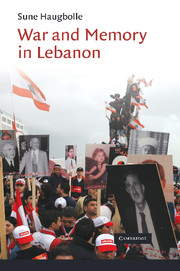Book contents
- Frontmatter
- Contents
- Figures
- Acknowledgments
- Note on Transliteration
- Acronyms
- War and Memory in Lebanon
- Prologue: A Hiatus of History
- 1 Remembering a War of Selves and Others
- 2 Culture, Politics, Civil War
- 3 Discourses on Amnesia and Reconstruction: Memory in the 1990s
- 4 Nostalgias
- 5 Inside Violence
- 6 Sectarian Memory Cultures
- 7 Truth Telling in the Independence Intifada
- Conclusion
- Bibliography
- Index
- Titles in the series
7 - Truth Telling in the Independence Intifada
Published online by Cambridge University Press: 05 May 2010
- Frontmatter
- Contents
- Figures
- Acknowledgments
- Note on Transliteration
- Acronyms
- War and Memory in Lebanon
- Prologue: A Hiatus of History
- 1 Remembering a War of Selves and Others
- 2 Culture, Politics, Civil War
- 3 Discourses on Amnesia and Reconstruction: Memory in the 1990s
- 4 Nostalgias
- 5 Inside Violence
- 6 Sectarian Memory Cultures
- 7 Truth Telling in the Independence Intifada
- Conclusion
- Bibliography
- Index
- Titles in the series
Summary
Truth and Remembering
Truth telling is the basic principle of national attempts to overcome past atrocities in transitional democracies around the world in the past three decades, from South America and Africa to Asia and Eastern Europe. Truth and reconciliation committees and truth reports in countries like South Africa, Chile and Argentina were created to let victims speak for themselves. By constructing a plot out of personal narratives, it was hoped that investigations, reports and public hearings would create ‘truths’ about the national past, authoritative interpretations of culpability, of conflict and of the best way out of its legacies (Phelps 2004). In some cases, truth telling has been linked to trials, whereas other countries have chosen to give amnesty in exchange for testimony. In Lebanon, where amnesty was given without a process of truth telling, this very concept became a cornerstone in the language of Beirut's memory makers. In this book, I have tried to illustrate the possibilities and complications that truth telling outside a sanctioned, national space involves. Perhaps the biggest complication is the fact that memories of victims are not staged in carno with their own bodies, histories and voices but are rather transmitted and represented by those who are centrally placed in hierarchies of national cultural production. These acts of representation create lacunae, exclusions and blatant misrepresentations, which are accepted or overlooked because they lend memory culture a constructive veneer.
- Type
- Chapter
- Information
- War and Memory in Lebanon , pp. 194 - 227Publisher: Cambridge University PressPrint publication year: 2010

